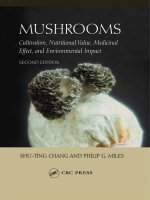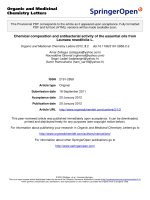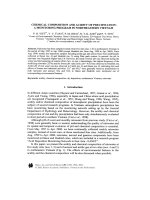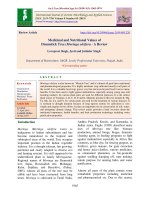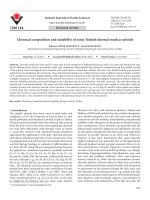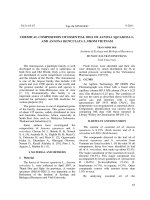Edible mushrooms chemical composition and nutritional value
Bạn đang xem bản rút gọn của tài liệu. Xem và tải ngay bản đầy đủ của tài liệu tại đây (4.49 MB, 237 trang )
Tai Lieu Chat Luong
EDIBLE MUSHROOMS
This page intentionally left blank
EDIBLE MUSHROOMS
Chemical Composition
and Nutritional Value
PAVEL KALAČ
Professsor of Agricultural Chemistry,
University of South Bohemia,
České Budějovice, Czech Republic
AMSTERDAM • BOSTON • HEIDELBERG • LONDON
NEW YORK • OXFORD • PARIS • SAN DIEGO
SAN FRANCISCO • SINGAPORE • SYDNEY • TOKYO
Academic Press is an imprint of Elsevier
Academic Press is an imprint of Elsevier
125, London Wall, EC2Y 5AS.
525 B Street, Suite 1800, San Diego, CA 92101-4495, USA
50 Hampshire St., 5th Floor, Cambridge, MA 02139, USA
The Boulevard, Langford Lane, Kidlington, Oxford OX5 1GB, UK
Copyright © 2016 Elsevier Inc. All rights reserved.
No part of this publication may be reproduced or transmitted in any form or by any
means, electronic or mechanical, including photocopying, recording, or any
information storage and retrieval system, without permission in writing from the
publisher. Details on how to seek permission, further information about the Publisher’s
permissions policies and our arrangements with organizations such as the Copyright
Clearance Center and the Copyright Licensing Agency, can be found at our website:
www.elsevier.com/permissions.
This book and the individual contributions contained in it are protected under
copyright by the Publisher (other than as may be noted herein).
Notices
Knowledge and best practice in this field are constantly changing. As new research
and experience broaden our understanding, changes in research methods, professional
practices, or medical treatment may become necessary.
Practitioners and researchers must always rely on their own experience and
knowledge in evaluating and using any information, methods, compounds, or
experiments described herein. In using such information or methods they should be
mindful of their own safety and the safety of others, including parties for whom they
have a professional responsibility.
To the fullest extent of the law, neither the Publisher nor the authors, contributors, or
editors, assume any liability for any injury and/or damage to persons or property as a
matter of products liability, negligence or otherwise, or from any use or operation of
any methods, products, instructions, or ideas contained in the material herein.
ISBN: 978-0-12-804455-1
British Library Cataloguing-in-Publication Data
A catalogue record for this book is available from the British Library
Library of Congress Cataloging-in-Publication Data
A catalog record for this book is available from the Library of Congress
For information on all Academic Press publications
visit our website at www.elsevier.com
Typeset by MPS Limited, Chennai, India
www.adi-mps.com
Printed and bound in the United States
Publisher: Nikki Levy
Acquisition Editor: Nina Bandeira
Editorial Project Manager: Mariana Kuhl Leme
Editorial Project Manager Inter: Ana Claudia A. Garcia
Production Manager: Lisa Jones
Marketing Manager: Ofelia Chernock
Cover Designer: Victoria Pearson
To my family for steady support and understanding.
This page intentionally left blank
CONTENTS
Preface
Acknowledgments
Biography
List of Figures
List of Tables
1.Introduction
xi
xiii
xv
xvii
xix
1
1.1 Basic Mycological Terms
4
References6
2. Proximate Composition and Nutrients
7
2.1 Dry Matter, Proximate Composition, and Energy Value
7
2.2Proteins
19
2.3Lipids
22
2.4 Carbohydrates and Dietary Fiber
32
2.4.1Sugars
33
2.4.2 Polysaccharides and Dietary Fiber
41
2.5 Major Minerals
45
2.6 Vitamins and Provitamins
49
2.6.1 Fat-Soluble Vitamins and Provitamins
49
2.6.2 Water-Soluble Vitamins
57
References60
3. Minor Constituents
3.1 Taste and Flavor Components
3.1.1Taste
3.1.2Flavor
3.2Pigments
3.3 Aliphatic Acids
3.4 Phenolic Compounds
3.5Sterols
3.6 Indole Compounds
3.7 Purine Compounds
3.8 Biogenic Amines and Polyamines
71
71
76
82
87
88
90
102
103
107
108
vii
viii
Contents
3.9 Trace Elements
111
3.9.1 Statutory Limits
111
3.9.2 The Effects of Environmental Factors on Trace Elements
in Fruit Bodies
112
3.9.3 Main Trace Elements
115
3.9.3.1Aluminum
116
3.9.3.2Arsenic
117
3.9.3.3Cadmium
118
3.9.3.4Chromium
119
3.9.3.5Cobalt
119
3.9.3.6Copper
119
3.9.3.7Iodine
120
3.9.3.8Iron
120
3.9.3.9Lead
120
3.9.3.10Mercury
121
3.9.3.11Nickel
122
3.9.3.12Selenium
122
3.9.3.13Zinc
123
3.9.4 Trace Elements with Limited Data
123
3.9.5 Concluding Remarks
124
References125
4. Health-Stimulating Compounds and Effects
137
4.1Antioxidants
138
4.2Beta-Glucans
140
4.3 Carbohydrates as a Potential Source of Prebiotics
142
4.4 Proteins with Specific Biological Roles
143
4.4.1Lectins
143
4.4.2Hemolysins
144
4.5Lovastatin
145
4.6Eritadenine
146
4.7 Gamma-Aminobutyric Acid
147
4.8Ergothioneine
147
References150
5. Detrimental Compounds and Effects
5.1 Potentially Procarcinogenic Compounds
5.1.1Agaritine
5.1.2Gyromitrin
155
155
156
158
Contents
ix
5.2Formaldehyde
159
5.3Nicotine
160
5.4Coprine
161
5.5Xenobiotics
161
5.6Nitrates
164
5.7Radioactivity
165
5.7.1 Radioactivity Units and Legislation
166
5.7.2 Natural Radionuclides
167
5.7.3 Anthropogenic Radionuclides
168
5.7.4 Mushroom Radioactivity After the Chernobyl Disaster
169
5.7.5 Radioactivity Burden from Mushroom Consumption
172
5.7.6 Radiocesium in Game-Feeding Mushrooms
173
5.8 Detrimental Effects of Tricholoma equestre174
5.9 Allergy and Adverse Dermal and Respiratory Reactions to Mushrooms 175
5.10 Microbial Load and Safety of Fresh Mushrooms
176
References177
6.Conclusions
6.1
6.2
6.3
6.4
Proximal Composition and Nutrients
Minor Constituents
Health-Stimulating Compounds and Effects
Detrimental Compounds and Effects
Appendix I: List of Abbreviations
Appendix II: Commonly Used Japanese Names of Mushrooms
Appendix III: Characteristics of the Main Fatty Acids Occurring in Mushroom Lipids
Index of Mushrooms Species
Subject Index
181
182
183
185
186
187
189
191
193
199
This page intentionally left blank
PREFACE
Wild-growing mushrooms have been a part of my life since early
childhood. A basket full of cepes and other valuable species was
prestigious for us country boys. We passed through forests very
early, even after daybreak. Our favorite dishes were only one of the
rewards. The mood of the temperate forests with their calm, various aromas, and changeableness within a day and within seasons
together with the esthetic look of mushrooms in their natural environment helped to form my stance in nature. Mushroom picking
has remained my tried and true recreational activity, until now.
During my academic work as a food and feed chemist, mushrooms have become a part of my research. To tell the truth, this
was never a funded project, it has only been a hobby. I have collected literature for decades, being focused on the chemical composition and nutritional value of both wild and cultivated edible
mushrooms. And only in my senior age have I found the time
and the courage to turn the expanding, but until now dispersed,
information into a book. This book does not deal with medicinal
and toxic species because data on these self-standing topics have
already been collected.
Although written primarily for nutritionists and mushroom producers, it is my hope that this book will prove useful for students of
food and human nutrition sciences and for mushroom fanciers.
Pavel Kalač
September 30, 2015
In České Budějovice
xi
This page intentionally left blank
ACKNOWLEDGMENTS
I am particularly indebted to my colleagues Professor Martin
Křížek, for his encouragement, Iveta Štefanová, MSc, for drawing chemical formulas and schemes, and Dr. Martin Šeda, for his
help during communication with the editors. Mushroom images
provided by Dr. Jan Borovička, Dr. Eva Dadáková, and Dr. Ivan
Jablonský are acknowledged. Moreover, I highly appreciate the
attitude and help of the Elsevier editors Ms. Nina Bandeira and
Ms. Ana Claudia Abad Garcia.
xiii
This page intentionally left blank
BIOGRAPHY
Pavel Kalač is a Professor of Agricultural Chemistry at University
of South Bohemia, České Budějovice, Czech Republic, where
he has served on the faculty since 1971. He graduated from
the Institute of Chemical Technology, Faculty of Food and
Biochemical Technology, Prague. Professor Kalač has published 63
articles registered in Scopus (60 in Web of Science), including 36
articles and reviews in Elsevier journals (particularly on the topics
of food chemistry (19) and meat science (8)).
He has published three books and numerous articles in Czech
that deal with food and feed chemistry, and his work is frequently
cited by researchers studying related topics.
The topic of edible mushroom chemistry has been his hobby
for decades.
xv
This page intentionally left blank
LIST OF FIGURES
Figure 1.1
Figure 3.1
Figure 3.2
Figure 3.3
Figure 3.4
Figure 3.5
Figure 3.6
Figure 3.7
Figure 4.1
Figure 4.2
Figure 5.1
Figure 5.2
Figure 5.3
A sketch of a mushroom.
Chemical structure of the main eight-carbon volatiles.
Chemical structure of lenthionine, which causes the valued
flavor of dried Lentinula edodes (shiitake) and its precursor,
lentinic acid.
Chemical structure of the main aliphatic acids occurring in
mushrooms.
Chemical structure of the main phenolic acids occurring in
mushrooms.
Indole-containing compounds detected in mushrooms.
Purine compounds contributing to mushroom taste.
Chemical structure of biogenic amines and polyamines
detected in mushrooms.
Chemical structure of eritadenine.
Chemical structure of ergothioneine and
gamma-aminobutyric acid (GABA).
A simplified scheme of carcinogen formation from agaritine.
A scheme of toxic hydrazine formation from gyromitrin.
A simplified scheme of toxic cyclopropanone hydrate
formation from coprine.
5
83
85
89
101
104
108
109
146
147
156
158
162
xvii
This page intentionally left blank
LIST OF TABLES
Table 1.1
Table 2.1
Table 2.2
Table 2.3
Table 2.4
Table 2.5
Table 2.6
Table 2.7
Table 2.8
Table 2.9
Table 2.10
Table 2.11
Table 2.12
Table 2.13
Table 2.14
Table 3.1
Table 3.2
Table 3.3
Production statistics of cultivated edible mushrooms, including
truffles, in 2013 (FAOSTAT)
Dry matter content (g 100 g−1 fresh matter), proximate
composition (g 100 g−1 dry matter), and energy (kcal kg−1 fresh
matter) of unprocessed wild-growing mushrooms
Dry matter content (g 100 g−1 fresh matter), proximate
composition (g 100 g−1 dry matter), and energy (kcal kg−1 fresh
matter) of unprocessed cultivated mushrooms
Variability of crude protein content in several mushroom species
Proportion of essential amino acids (% of total amino acids) in
mushroom proteins
Proportion of major fatty acids (% of total fatty acids) in selected
mushroom species
Contents of soluble sugars and polyols (g 100 g−1 dry matter) in
selected mushroom species
Mannitol and trehalose contents (g 100 g−1 dry matter) in
preserved and cooked mushrooms
Content of total, insoluble, and soluble dietary fiber (g 100 g−1
dry matter) determined by AOAC enzymatic-gravimetric
method in selected wild mushroom species
Proportion of total dietary fiber (TDF; % of dry matter) and
monosaccharide composition of total dietary fiber (% of total
polysaccharides). The values were determined by Uppsala
Methods
Variability of ash content in several mushroom species
Usual content (mg 100 g−1 dry matter) of major mineral
elements in wild-growing mushrooms
Variability in three major minerals (mg 100 g−1 dry matter)
Content of fat-soluble provitamin ergosterol (mg 100 g−1 dry
matter) and tocopherols (μg 100 g−1 dry matter) in selected
mushroom species
Mean contents of water-soluble vitamins (mg or μg 100 g−1
dry matter)
Content of free amino acids (mg g−1 dry matter) affecting the
taste of fresh mushrooms
Content of total and flavor 5′-nucleotides (mg g−1 dry matter)
affecting taste of fresh mushrooms and equivalent umami
concentration (EUC; g monosodium glutamate 100 g−1 dry
matter)
Content of aliphatic acids (mg 100 g−1 dry matter) in selected
mushroom species
2
8
14
20
21
24
34
40
43
44
46
46
47
50
58
72
74
77
xix
xx
List of Tables
Table 3.4
Table 3.5
Table 3.6
Table 3.7
Table 4.1
Table 4.2
Table 4.3
Table 5.1
Content of phenolic acids (mg 100 g−1 dry matter) in selected
mushroom species
Content of indole compounds (mg 100 g−1 dry matter) in
selected fresh mushroom species
Usual content (mg kg−1dry matter) of main trace elements
in mushroom fruit bodies from unpolluted areas and
accumulating genera and species known currently
Usual content (mg kg−1dry matter) of trace elements with
limited data in mushroom fruit bodies from unpolluted areas
and accumulating genera and species known currently
Common name (or symbol) of β-glucans isolated from various
mushroom species
Content of lovastatin (mg 100 g−1 dry matter) in selected
mushroom species
Content of γ-aminobutyric acid (GABA) and ergothioneine
(mg 100 g−1 dry matter) in selected mushroom species
Selected edible mushroom species with different rates of
radiocesium 137Cs accumulation
92
105
116
124
141
145
148
171
CHAPTER 1
Introduction
Contents
1.1 Basic Mycological Terms
4
References6
Fresh and preserved mushrooms are consumed in many countries as a delicacy, particularly for their specific aroma and texture,
but also for their low energy level and fiber content. However,
mushrooms became a required part of nutrition during periods of
staple food shortage, such as during wars. Approximately 14,000
mushroom species, described according to the rules of mycological nomenclature, represent approximately 10% of the estimated
number of species existing on Earth. More than 2000 species are
safe for consumption, and approximately 700 species are known
to possess significant pharmacological properties (Wasser, 2002).
Information on number of edible species collected for culinary
purposes throughout the world varies widely between 200 and
3000. Approximately 100 species can be cultivated commercially, but only 10–20 of them can be cultivated on an industrial
scale (Chang and Miles, 2004). The mushroom industry has three
main segments: cultivated edible, wild-growing, and medicinal
mushrooms.
According to FAOSTAT data (Table 1.1), the total world production of cultivated mushrooms was nearly 10 million tons in
2013, whereas it was only 4.2 million tons in 2000. China has
been the leading producer by far. The most produced species is the
Agaricus bisporus (white or button mushroom, brown mushroom, or
portobello), dominating worldwide, followed by Lentinula edodes
(commonly called by its Japanese name, shiitake), a species of genus
Edible Mushrooms.
DOI: />
© 2016
2014 Elsevier Inc.
All rights reserved.
1
2
Edible Mushrooms
Table 1.1 Production statistics of cultivated edible mushrooms, including
truffles, in 2013 (FAOSTAT)
Country
Production (metric tons)
World production (%)
China
Italy
USA
Netherlands
Poland
Spain
France
Canada
United Kingdom
Ireland
Japan
World
7,068,102
792,000
406,198
323,000
220,000
149,700
104,621
81,788
79,500
93,600
61,500
9,926,966
71.20
7.98
4.09
3.25
2.22
1.51
1.05
0.82
0.80
0.64
0.62
100.00
Pleurotus (particularly P. ostreatus, oyster mushroom, hiratake), and
Flammulina velutipes (golden needle mushroom, enokitake). Only
approximately 45% of produced mushrooms are culinary-processed
in the fresh form. The rest are preserved, mostly by canning and
drying, with a ratio of approximately 10:1.
Consumption of wild-growing mushrooms has been preferred
to cultivated species in many countries of Central and Eastern
Europe due to species diversity and more savorous properties.
Moreover, mushroom picking in forests and grasslands, as a lasting
part of cultural heritage, has become a highly valued recreational
activity in these countries. The collection of wild mushrooms
can be seen as a relic of bygone gatherers and hunters. Moreover,
mushrooms in their natural habitat are regarded for their esthetic
value. This attitude is quite different from that of countries where
wild mushrooms have been ignored as “toadstools.”
Mushrooms have been collected mostly as a delicacy for the
pickers’ own consumption; however, the collection has been
an economic activity for some rural populations. For instance,
the picking is a “national hobby” in the Czech Republic.
Interestingly, approximately 70% of the population picks
Introduction
3
mushrooms, with a statistical mean of 5–8 kg of fresh mushrooms per household or 2–3 kg per capita yearly. Some individuals consume more than 10 kg yearly. The factual consumption is
lower due to removal of parts damaged by animals or insect larvae. In Finland, approximately 42% of households were engaged
in picking, with a total harvest of 15,000 metric tons in 2011.
Information on the harvest of wild-growing species worldwide is
lacking.
Fresh mushrooms rank among the most perishable food materials, with a very short shelf life of only 1–3 days at ambient temperature. This considerably limits their distribution and marketing.
Deterioration after harvesting, such as color changes, particularly
browning, weight loss, texture changes, or cap opening, is caused by
high water content, high respiration rate, and lack of physical protection to avoid water loss (transpiration) and microbial attack. Various
endogenous enzymes participate in biochemical changes after disruption of cellular integrity such as by mechanical damage of tissues.
Quick deterioration of mushrooms has been an obstacle for
both manufacturers and consumers. Drying, canning, or deepfreezing have been traditionally used for mushroom preservation; however, emerging technologies have been studied. Gamma
irradiation has been shown to be a preservation method that
saves chemical parameters of various mushroom species to a
greater extent than drying or freezing (Fernandes et al., 2012).
Nevertheless, the period between research results and industrial
application can be rather long.
The following chapters provide recent overall knowledge and
include data and references since 2000. It is not possible to cite
all original works. Partial reviews, when available, are thus preferentially referred to and have numerous earlier references therein.
Such reviews dealing with mushroom chemical composition and
nutritional value were published during the past decade (Bernaś
et al., 2006; Kalač, 2009, 2012, 2013; Wang et al., 2014). Most of
the available data deal with European and East Asian edible species, often called culinary mushrooms.
4
Edible Mushrooms
Many mushroom species are toxic. The inability of immobile
higher fungi to escape from an attack by fungivores, ranging from
insects to mammals, has led to the evolution of several defense
strategies to deter the pests. Fruit bodies of fungi often produce
toxins and pungent or bitter compounds to deter fungivores (for
an overview see Spiteller, 2008). This book does not focus on
toxic mushroom species because such information is accessible
elsewhere.
Similarly, this book does not deal with medicinal species,
which are widely used in East Asian folk medicine and have been
recently extensively studied as potential sources of novel drugs.
Commercial products from medicinal mushrooms have been
obtained from large-scale cultivation of fruit bodies. However,
under such conditions it is difficult to sustain a regular level of
effective compounds. Therefore, the production of fungal mycelium by submerged cultivation increases. The medicinal targets
are very wide; antioxidant, antitumor, antidiabetic, antimalarial,
antiviral, antimicrobial, anti-Alzheimer, and hypocholesterolemic
activities have been observed. The specialized International Journal
of Medicinal Mushrooms has been published since 1999. Several
overviews of the topic are available (eg, De Silva et al., 2013;
Lindequist et al., 2005; or Wasser, 2010).
1.1 BASIC MYCOLOGICAL TERMS
Scientific (Latin) names are used in the text because common
names (eg, chanterelles, boletes, cepes, or truffles) are widely
known for only the most consumed species, whereas less frequent
mushroom species have more locally common names.
The term “mushroom” is used for a distinctive fruit body
(mycocarp or carpophore) of a macrofungus (or higher fungus) that is large enough to be seen by the naked eye and to be
picked up by hand. For culinary species, the term is used for the
harvested, processed, and consumed part of macrofungi. Fruit
